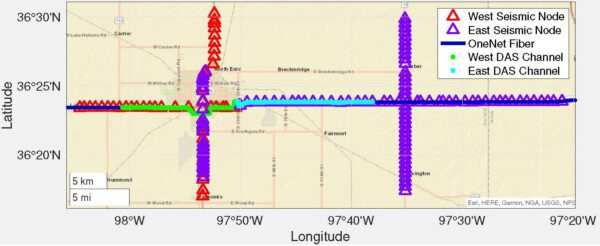University of Oklahoma Partners with OneNet to Measure Seismic Earthquake Activity
OneNet and the University of Oklahoma recently teamed up to deploy a novel new technology that measures earthquakes and other natural disasters. OU researcher Xiaowei Chen contacted OneNet about deploying new research equipment along one of OneNet’s fiber routes for her study. She hoped to gain insight into shifts that happen underground and the waves that are emitted to learn more about why and how earthquakes happen.
Upon hearing about the project, OneNet was excited to partner with Chen after reading about a similar project that had been conducted in California, the earthquake center for America. The information gained there provided researchers with insight into the details of the subsurface and how and when extreme environmental events are occurring. The novel technology utilized for the project is called distributed acoustic sensing (DAS), an up-and-coming application being used to measure the shifting of tectonic plates that cause earthquakes and other natural disasters.
The DAS technology was used in California with the intention to measure vibrations from earthquakes and gain a new insight into urban hazard assessment and control. During spring and summer 2021, the collaboration between OU and OneNet led to the first DAS project in Oklahoma. The project was led by Chen, who is the Lissa and Cy Wagner Associate Professor & Stubbeman-Drace Presidential Professor in the School of Geo-sciences at OU. Chen’s goal was to measure ground vibrations emitted from earthquakes, as well as cars and infrastructures (e.g., factories, wind farms) along OneNet’s fiber route, in hopes of having better understanding of the subsurface and urban hazards.

Figure 1. From Zhan, 2019 to demonstrate the principles of DAS. The DAS interrogation unit is connected to one end of a long optical fiber cable (in this case, the hub is located on NWOSU Enid campus). The DAS unit sends laser pulses to the fiber, and interrogates the back scattered light from intrinsic fiber defects. Real-time data processing will detect strain perturbations occurring at different locations along the fiber. Two-way light travel time can determine the distance between each channel and the interrogation unit. The field crew perform tap test to obtain precise locations of seismic channels.
DAS uses optical fibers typically used for internet services and telephone communication and converts the fiber cables into densely spaced seismic channels to record ground vibrations (Figure 1). Chen worked with OneNet’s Director of Network Infrastructure Randy Crosby to identify the best fiber route for this application. They chose a route along State Highway 412 at OneNet’s hubsite on the Northwestern Oklahoma State University campus in Enid, Oklahoma.
DAS allows researchers to see below the Earth’s surface in order to monitor the shifts in the subsurface, faults, fractures and soil conditions. Something unique about DAS is that it is that it has a higher spatial meter-scale resolution allowing researchers to see the subsurface much clearer than ever before.
“We connected a Silixa iDAS interrogation unit (IU) to fibers extending along state Hwy 412. The IU inputs pulses of laser light into the optical fiber and measures the light that is backscattered,” Chen said. “Acoustic waves from earthquakes or passing vehicles cause strain in the optical fiber and affect the measured back-scattered light thus allowing us to measure the acoustic field.”
In Pennsylvania, another application of this research utilized DAS via an existing fiber network to successfully detect thunderstorm-induced seismic events. The success of these projects opens up new possibilities to further understand extreme weather events and potentially conduct more cutting-edge research.

Figure 2. Map view of the fiber and seismic node. The green and cyan dots represent mapped DAS channels along OneNet fiber, which is shown by solid dark blue line. The red and purple triangles represent seismic instruments (3C Fairfield nodes). The figure is made in Matlab using the open streets base map.
OU’s field crew and researchers also used seismic equipment from the School of Geo-science and deployed dense seismic nodal arrays to compare the signal from DAS channels and seismometers (Figure 2). The fiber recorded a heavy vehicle moving from east to west and several vehicles traveling along state highways. The fiber also recorded traffic data around Enid in April and July, flowing eastward and westward due to the vibrational wavelengths they gave off. The iDAS unit recorded a total of 64 TB of data at 1000 Hz sampling rate from both the east and west segments. Archiving this large quantity of data from this project is made possible by the OU Supercomputing Center for Education and Research.
DAS research like this project offers promising opportunities for applications in a variety of areas, and Chen hopes her research makes a difference in several ways.
“The goal of co-current seismic array is to compare and validate the signal recorded by the iDAS unit to better understand the signal characteristics and better characterize the signals coming from earthquakes, and some companies have started to use these techniques to detect pipeline leaking, excavations, explosions, traffic and many more,” says Chen.
“This study was a great opportunity for OneNet to support higher education research initiatives in Oklahoma,” said Crosby. “As higher education’s partner in research and education, we hope to offer our resources to more collaborations like this in the future.”
Story by Dominique Brignac, Strategic Communications Intern, Fall & Spring 2021
